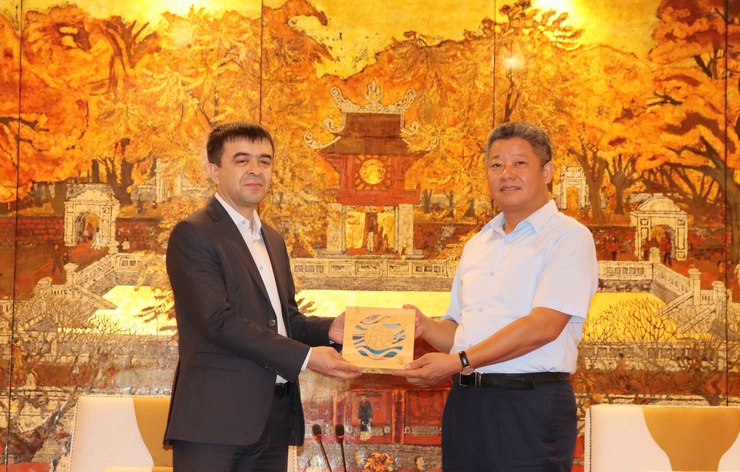At the meeting, Nguyen Van Chi, Head of Hanoi's Rural Development Sub-department, shared that from October 21 to 23, the World Crafts Council delegation had conducted surveys and evaluations of the criteria for recognizing Bat Trang Pottery Village (Gia Lam District) and Van Phuc Silk Village (Ha Dong District) as members of the World Creative Craft Cities Network.

Vice Chairman of the Hanoi People's Committee Nguyen Manh Quyen and Chairman of the World Crafts Council for Asia-Pacific Region Aziz Murtazaev.
The Council praised Bat Trang Pottery Village for not only meeting all the criteria of a traditional craft village but also being worthy of joining the global network of creative craft cities. Additionally, the Council acknowledged the unique cultural and historical values of Van Phuc Silk Village, particularly its long-standing heritage and development.
Aziz Murtazaev, Chairman of the World Crafts Council for the Asia-Pacific Region and head of the delegation, expressed gratitude for the warm welcome from the leadership of Hanoi. He stated that during their survey in Hanoi, the delegation gained an overall view of both Bat Trang Pottery Village and Van Phuc Silk Village, noting, "We are truly impressed by the history, tradition, and values of these craft villages and the dedication of the artisans in preserving and developing Hanoi's craft villages."
The World Crafts Council representatives remarked that few places in the world have the potential for craft village development like Hanoi. They suggested that Hanoi should prioritize craft villages in its development strategy, enhancing investment and promotion so that the city's craft products gain more international recognition.
They also provided constructive feedback on areas for improvement in the development of Bat Trang Pottery Village and Van Phuc Silk Village, while expressing their willingness to collaborate with Hanoi to bring in global experts, businesses, and artisans for exchanges and knowledge-sharing on craft village development.
Vice Chairman of the Hanoi People's Committee, Nguyen Manh Quyen, highlighted that Hanoi is home to 1,350 craft and traditional craft villages, accounting for 56% of the country's total. He emphasized that craft villages are identified as one of Hanoi's key development strengths.
He expressed hope that the World Crafts Council would support Hanoi in realizing its goal of sustainable craft village development, enabling artisans and residents not only to make a living but also to prosper through their traditional crafts.
Regarding the Council's recommendations for the development of Bat Trang and Van Phuc villages, he instructed the Hanoi Department of Agriculture and Rural Development to study and implement appropriate solutions. He also emphasized the need to maintain regular communication and propose cooperation programs for the most effective collaboration with the World Crafts Council in the future.
Ngoc Mai